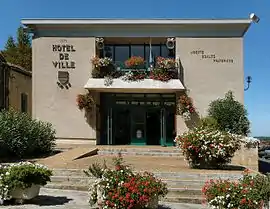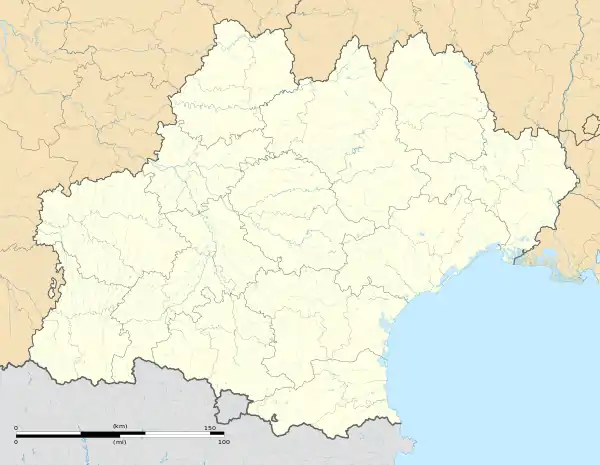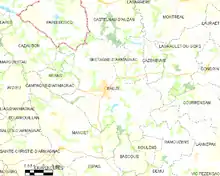Eauze
Eauze (pronounced Éauze; Gascon: Eusa) is a commune in the Gers department in southwestern France.
Éauze | |
|---|---|
 The town hall in Eauze | |
.svg.png.webp) Coat of arms | |
Location of Éauze 
| |
 Éauze  Éauze | |
| Coordinates: 43°51′44″N 0°06′07″E | |
| Country | France |
| Region | Occitanie |
| Department | Gers |
| Arrondissement | Condom |
| Canton | Armagnac-Ténarèze |
| Intercommunality | Grand Armagnac |
| Government | |
| • Mayor (2014-2020) | Michel Gabas |
| Area 1 | 72.00 km2 (27.80 sq mi) |
| Population (2017-01-01)[1] | 3,918 |
| • Density | 54/km2 (140/sq mi) |
| Time zone | UTC+01:00 (CET) |
| • Summer (DST) | UTC+02:00 (CEST) |
| INSEE/Postal code | 32119 /32800 |
| Elevation | 106–193 m (348–633 ft) (avg. 126 m or 413 ft) |
| 1 French Land Register data, which excludes lakes, ponds, glaciers > 1 km2 (0.386 sq mi or 247 acres) and river estuaries. | |
History
Located in the heart of south-west France, 130 kilometers from the Spanish border, Eauze is originally a proto-Basque city that became Roman. It was the capital of the Roman province of Novempopulania until the eighth century. Its Latin name, Elusa, is identical to that of a titular see of Palaestina Tertia, suffragan of Petra.
Geography
Eauze is twinned with Ampuero (Spain).
Climate
The weather is typical of the southwestern French climate, characterized by an oceanic influence and high temperatures in summer. The annual sunshine is around 2,000 hours. In winter, frosts can be large and reach a minimum early morning temperature of -5 °C. On the other hand, summers are favorable to the strong heat and the proximity of the ocean accentuates the temperatures felt which regularly reach 35 to 38 °C. In spring and autumn, temperatures range from 12 to 27 °C.
Sites of interest
Éauze Cathedral is dedicated to Saint Luperculus, who is said to have been a bishop here in the third century before being martyred.
Events
Éauze has a market on Thursday mornings and there is also a separate poultry and rabbit market.

Population

| Year | Pop. | ±% |
|---|---|---|
| 2006 | 3,923 | — |
| 2007 | 3,929 | +0.2% |
| 2008 | 3,935 | +0.2% |
| 2009 | 3,953 | +0.5% |
| 2010 | 4,092 | +3.5% |
| 2011 | 4,020 | −1.8% |
| 2012 | 3,949 | −1.8% |
| 2013 | 3,877 | −1.8% |
| 2014 | 3,851 | −0.7% |
| 2015 | 3,869 | +0.5% |
| 2016 | 3,894 | +0.6% |
See also
References
- "Populations légales 2017". INSEE. Retrieved 6 January 2020.
 This article incorporates text from a publication now in the public domain: Herbermann, Charles, ed. (1913). Catholic Encyclopedia. New York: Robert Appleton Company. Missing or empty
This article incorporates text from a publication now in the public domain: Herbermann, Charles, ed. (1913). Catholic Encyclopedia. New York: Robert Appleton Company. Missing or empty |title=(help)